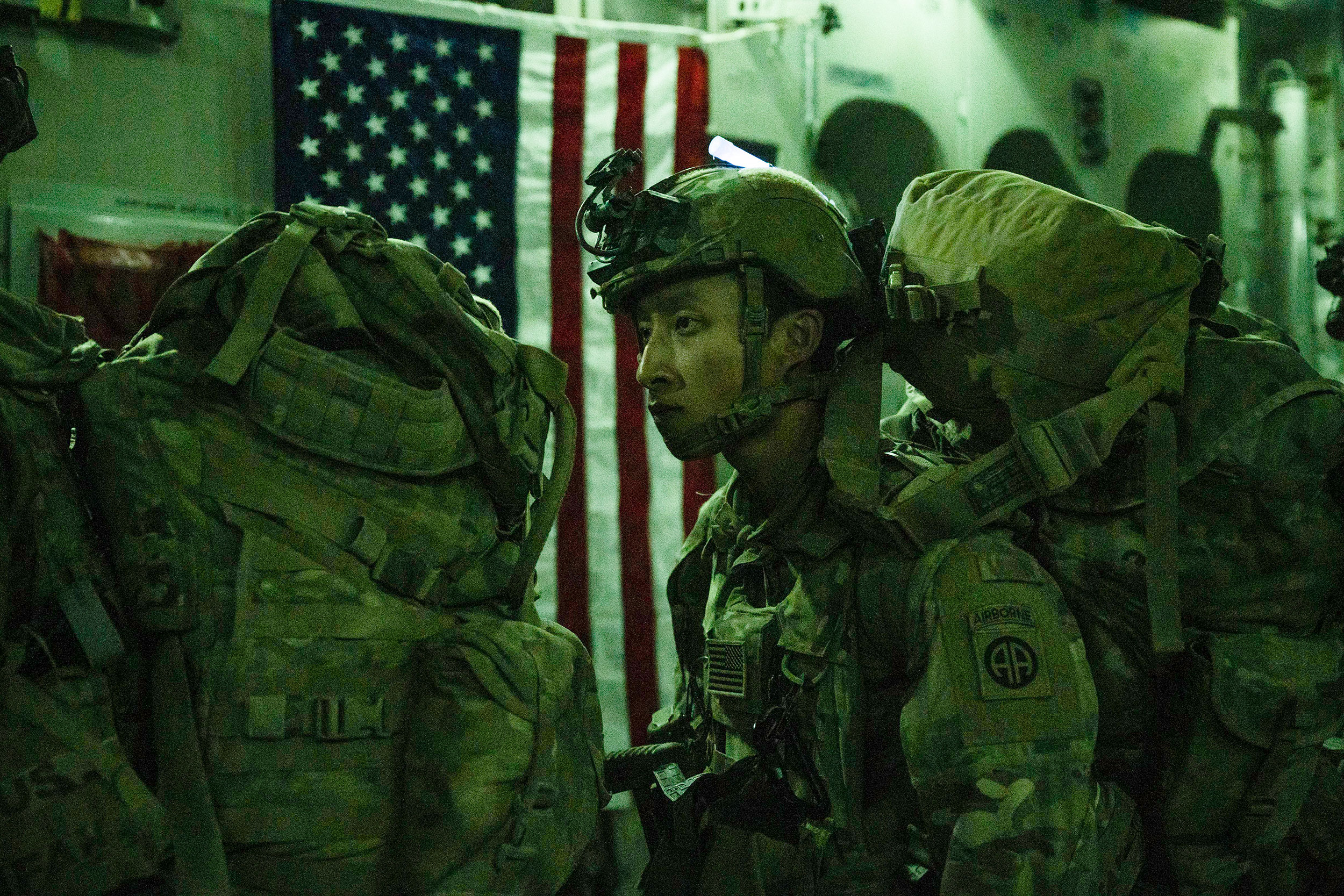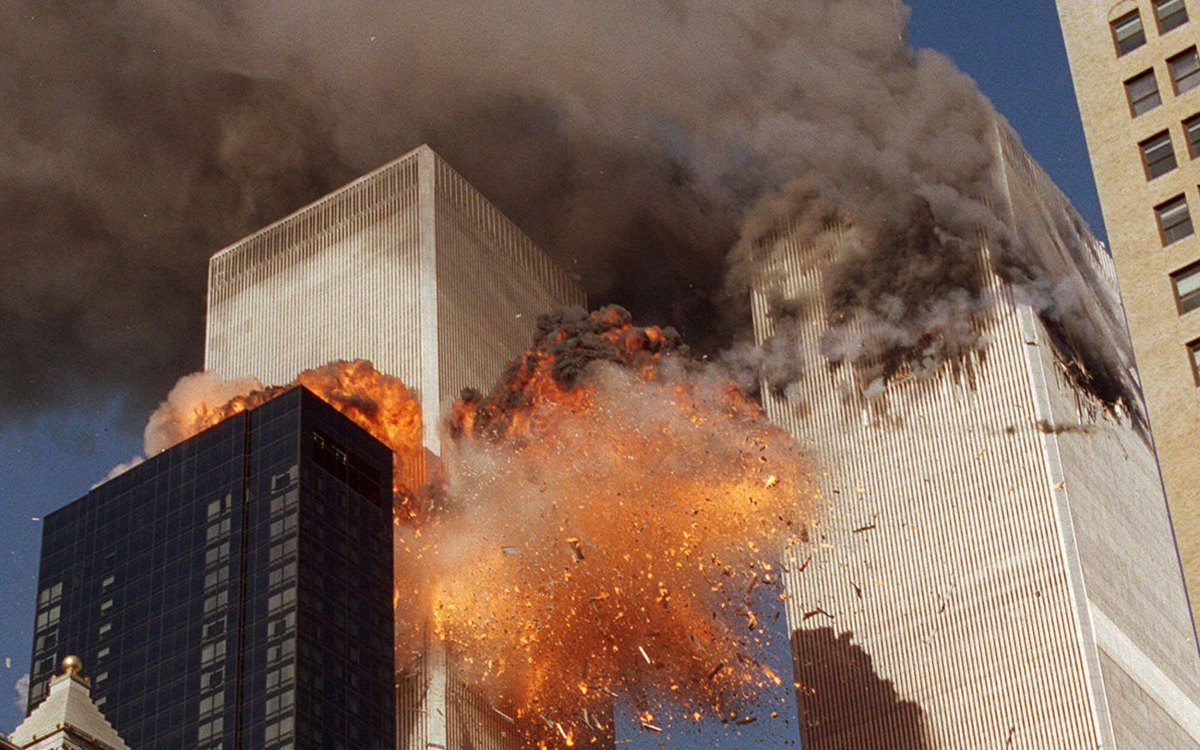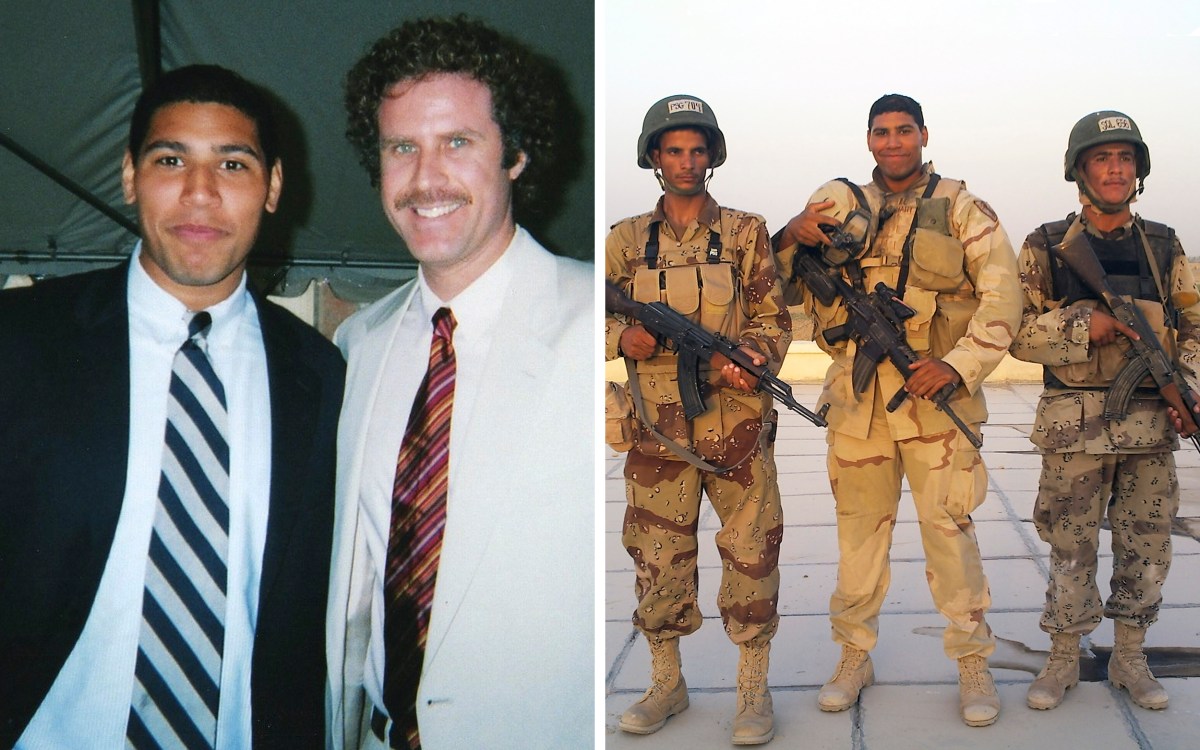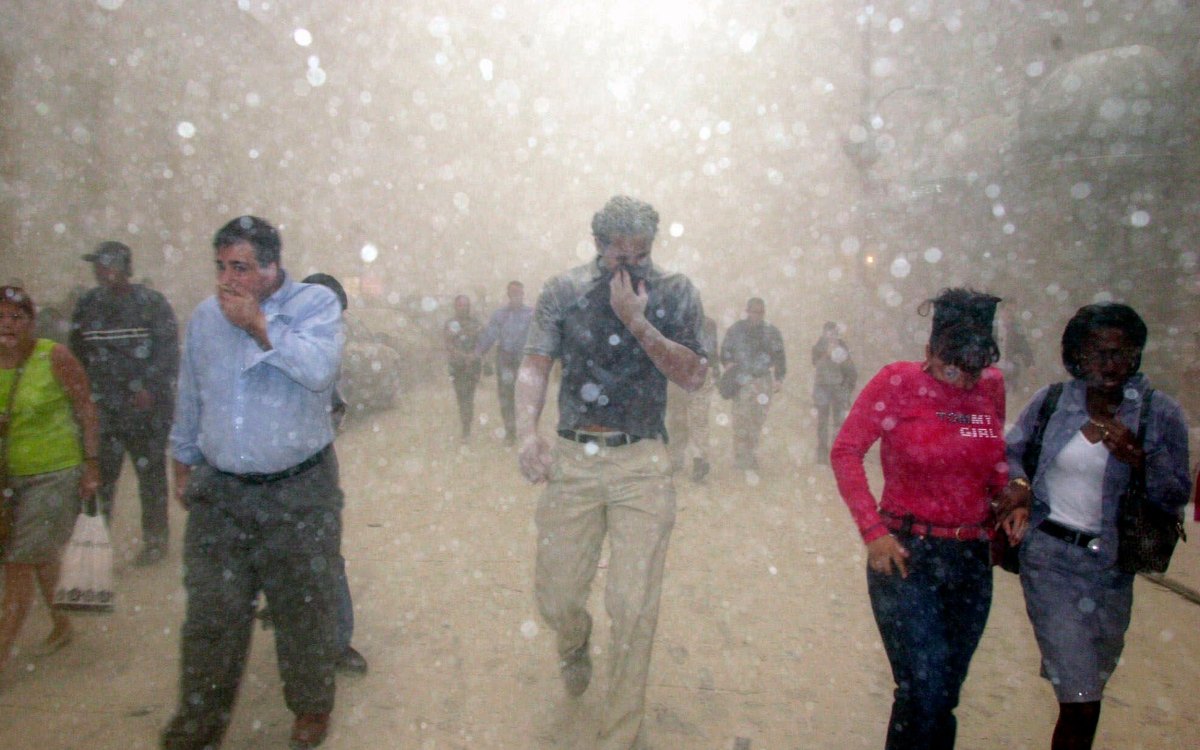
A soldier assigned to the 82nd Airborne Division helps with an evacuation at Hamid Karzai International Airport in Kabul, Afghanistan.
Senior Airman Taylor Crul/U.S. Air Force via AP
Hard lessons from 9/11
Professors detail how it reshaped homeland security, foreign policy, study and treatment of PTSD, and crisis planning and management
Beyond their vast and terrible human toll, the 9/11 terrorist attacks changed and continue to influence life in America in myriad ways. Harvard professors detail how the tragedy reshaped U.S. homeland security and foreign policy, changed the study and treatment of post-traumatic stress disorder (PTSD), led to a nationwide overhaul of crisis planning and management, and prompted substantial new regulatory changes in rules for building and fire safety.
Homeland Security and Foreign Policy
Is America safer from attack by Islamic terrorists than it was 20 years ago or was the war on terror a failure?
Many people are asking those questions now, after the recent messy withdrawal of American forces from Afghanistan and the return to power there of the Taliban. The decision to leave the country ended a costly 20-year war — increasingly unpopular in the U.S. — that was launched in retaliation for the 9/11 attacks by al-Qaida, which had found safe harbor in the south Asian nation.
“The Taliban flag will be waving in Afghanistan on Sept. 11. That is your split screen. There’s just no question about it,” said Juliette Kayyem ’91, J.D. ’95, Belfer senior lecturer in international security at Harvard Kennedy School (HKS).
“But I think it’s much more complicated and unfair to our efforts” to conclude that because the Taliban was not defeated, the U.S. wasted $2.2 trillion and thousands of lives in Afghanistan. “It’s not nothing, and it’s not luck that there was no similar size 9/11 attack in the U.S. for 20 years,” she said.
Without a military presence in Afghanistan, there will be a “detrimental impact” on future U.S. counterterrorism efforts, but “we’re not back to Sept. 10,” said Kayyem.
The counterterrorism capacity and capabilities of the U.S. and our Western allies have improved over the past two decades, especially in surveillance, droning, and information sharing, and U.S. homeland security is far more robust, said Kayyem, a former assistant secretary in the Department of Homeland Security in the Obama administration.
But concerns remain. The withdrawal will be viewed in parts of the Arab world as a Taliban victory over the U.S. and undoubtedly help terrorist recruitment. It will also provide political fodder for critics of U.S. hegemony and interventionism. In addition, some Afghan refugees who have difficulty transitioning in their new countries could prove susceptible to radicalization, Kayyem said.
Though the Taliban controls more territory today than it did on 9/11, the early U.S. counterterrorism efforts were “broadly successful” in weakening al-Qaida and the Taliban and preventing terrorist attacks, said Fredrik Logevall, Laurence D. Belfer Professor of International Affairs at HKS and a professor of history on Harvard’s Faculty of Arts and Sciences.
However, the Bush administration’s pivot to Iraq in 2003 set the mission adrift, and the failed effort to establish a democratic Afghan government after Osama bin Laden’s death [in 2011] deeply undermined that early success, said Logevall.
“The historian in me wants to say that it’s too soon to know if the war on terror was a failure,” he said. “But given the expenditures involved, [which were] massive, given the costs — in all respects of the term ‘cost’— of the interventions in Afghanistan and Iraq, both with respect to conditions in those countries, but also in the region, I think the picture is a pretty grim one.”
Other costs are lost time and opportunity.
“Waging that counterterrorism has diverted attention from the complex challenges posed, for example, by a rising China, by Russia, by a nuclear North Korea,” said Logevall.
A U.S. foreign policy retrenchment could be on the horizon, given the strong public support for the decision to end the war, he said, along with the fierce criticism of the Biden administration’s execution of the withdrawal.
“It’s clear that Joe Biden has, for a long time, been skeptical about using American military power to turn this or that country into a democracy, and he’s a skeptic about nation-building. So, I think we probably won’t see a lot of effort in that direction,” he said.
But the blowback could also provoke Biden to become more assertive in projecting American military power, said Logevall.
“There’s a nontrivial chance that the administration will want to show, ‘Hey, we’re still in the game, and we’re still the force to be reckoned with.’”
Post-Traumatic Stress Disorder (PTSD)
Unlike many disasters, 9/11 was a uniquely communal event: It occurred on live television, targeted symbols of American business and government everyone recognized, and claimed victims engaged in everyday activities, like going to work or taking an airline flight.
“I think 9/11 was a collective trauma for the nation,” said Richard F. Mollica, professor of psychiatry and founding director of the Harvard Program in Refugee Trauma (HPRT), which conducts training and scientific research and provides mental health services to people in conflict areas and who have experienced natural disasters. “We all realized, as a nation, our vulnerability to these terroristic life events.
Before 9/11, public understanding of post-traumatic stress disorder (PTSD) was limited, and trauma was still an emerging field of study.
“In those early days, people only thought of trauma around war veterans” said Karestan Koenen, a professor of psychiatric epidemiology at Harvard T.H. Chan School of Public Health who studies PTSD. “I think the 9/11 terrorist attacks really brought home that trauma could happen to anyone, that it can happen and not be your fault.”
The attacks sparked “a revolution” in the field’s thinking about self-care for trauma victims as well as for those who treat them. “In 2001, no one was talking about burnout; no one was talking about self-care; no one was talking about resiliency,” said Mollica.
Sept. 11 showed that some treatments for trauma victims did more harm than good. One treatment that was untested but thought to be therapeutic was “critical incident stress debriefing,” in which people were asked to talk about their experiences, often in minute detail.
“They were activating in people high emotional arousal, and all the research that was done following that showed it actually generated post-traumatic stress disorder and depression and made people sick,” said Mollica. The Harvard Program on Refugee Trauma first developed the Harvard Trauma Questionnaire, a well-known mental health assessment tool, back in the 1980s. “And so, one of the big outcomes of 9/11 was that debriefing was thrown out as part of the psychological first aid.”
“It really brought home the importance of studying [which] treatments are effective and why research on treatment is really important,” said Koenen.
In fact, New Yorkers were far more resilient than many experts had predicted. Traumatologists were surprised to see that what appeared to be elevated rates of PTSD dropped dramatically not long after 9/11, suggesting that they “mistook ordinary stress reactions (e.g., insomnia, anger, intrusive images) as the psychiatric illness of PTSD,” said Richard McNally, a psychology professor who studies anxiety and panic-related disorders.
That misreading underscored the need for the field to focus more on early intervention and prevention in order to be able to answer such key questions as whether we can predict who is most likely to get PTSD, identify those individuals early on, and prevent its onset.
After 9/11, many more were drawn to the field, and the scientific community began to pay closer attention to the disorder. As part of the genomic revolution, the study of the genetics of PTSD and the role that genetic factors play in shaping the response to trauma grew dramatically, said Koenen, who works in this area.
“Before 9/11, a lot of people still dismissed PTSD as a real thing. And 9/11 made it into something more legitimate to study,” said Koenen, who said she had been discouraged from working on trauma as a postdoc in 2001. Sept. 11 spurred more biologically-based research, and there was a huge growth in imaging, brain-related research, and biomarkers, in part because of significant new government investment in 9/11-related scientific research.
Koenen said the work done in the aftermath of 9/11 demonstrated to the public the links between disasters and mental health, paving the way to quicker response to mental health concerns during the pandemic, with increased research and public health outreach, broader public awareness, and acceptance of treatment options as a critical need.
“It’s clear that mental health was top of mind very early, and I’m not sure without 9/11 whether that would have been true,” she said.
Preparation for Crisis Response
On 9/11 Joseph Pfeifer was a 20-year veteran of the New York City Fire Department, a battalion chief in charge of four firehouses in lower Manhattan, including one across from the World Trade Center. He was out on a call just blocks away when he saw the first plane hit the north tower. As the first chief on the scene, he radioed for a second, then a third alarm, and ordered the first wave of firefighters to begin evacuating the building.
“I knew I was responding to the largest and the most dangerous fire of my life,” he said.
First responders had years of training and experience. Pfeifer, now a senior fellow with the Program on Crisis Leadership at HKS, said that in hindsight there were critical gaps in their preparation as well as in the communication and collaboration between agencies. Police and fire units set up operations blocks apart, adding to the technical difficulties of radio communications. There was limited video and data and uneven information sharing, all of which complicated decision-making.
“I would have loved to have seen 10 seconds of [news] video of the south tower collapsing. I had no idea that building fell down. And yet, I ordered our firefighters to evacuate the north tower,” said Pfeifer, who details in a new memoir how his brother, also a firefighter, perished while rescuing people trapped inside the north tower. “I would have done it more urgently if I knew the whole building [had] collapsed.”
After-action analyses confirmed that closer coordination between responding agencies, between federal, state, and local governments, and more comprehensive preparation and training were needed.
Arnold Howitt, founding faculty co-director of the Program on Crisis Leadership, said Sept. 11 (and later, Hurricane Katrina) demonstrated that extreme emergencies could unfold much more quickly and at far greater scale than previously understood.
The federal government began investing heavily in research and training around crisis planning and management in order to do a better job preparing for and responding to more routine emergencies, like major snowstorms, and novel crises, like a terrorist attack. In 2004, FEMA introduced the National Incident Management System, a framework to assist governments, nongovernmental organizations, and the private sector to deal with emergencies.
Looked at broadly, public safety and public health agencies are better prepared, have more thorough training, and greater ability to quickly adapt to changing circumstances and improvise where necessary than they did in 2001, said Howitt.
Communication with the public, now seen as critical to any effective emergency response, has advanced. And the principles and value of collaboration up and down all levels of government, between political leaders and their agency professionals, and across disciplines are far better appreciated nationally than 20 years ago, he said.
“Very, very rarely do these large events fit into the skill sets and the responsibilities of a single agency,” Howitt said. “Building those kinds of cooperative relationships has definitely improved significantly in the years since, but it’s also still unevenly implemented.”
Federal agencies, however, are limited in what they can do on their own. States and local municipalities retain significant authority and control over what actions can be taken and by whom. Even private businesses sometimes have a say, for example, when hospitals or medical professionals are involved.
That makes it harder for the federal government to act quickly in a unified and cohesive way and leads to highly varied crisis responses around the country, limitations that became evident throughout the COVID response, said Howitt.
Structural Engineering and Fire Safety
The sudden destruction of the twin towers, whose design had been hailed as innovative in the late 1960s, raised serious questions about the soundness of the World Trade Center’s construction and fire safety.
“Structural engineers like myself were shocked,” that such iconic structures had been attacked and then had to watch as they burned and collapsed, said Hanif Kara, professor in practice of architectural technology at Harvard Graduate School of Design.
“There’s a consensus among structural engineers that the inherent strength and robustness of each tower’s structure prevented an immediate collapse,” said Kara. Since then, much work has been done to understand what caused the collapse, and among the complex findings, “there is little doubt that fire-protection was a major failing.”
Though 9/11 did very little to dampen enthusiasm for super-tall skyscrapers — at least 40 buildings around the world now surpass the 1,368-foot height of the doomed World Trade Center — it did prompt important changes to the way they are built.
In 2005, the U.S. National Institute of Standards and Technology (NIST) issued 30 recommendations for revisions to building fire codes, standards, and practices. More active approaches to fire-safety during construction are now common. Building frames must now include fire protection and engineers can use computational analysis to model what could happen structurally in a fire rather than relying on defensive fire protections.
How people exit high-rise buildings in an emergency has also changed since 9/11.
“As a consequence of the twin towers’ occupants being trapped within the stairways, which were only [44 or 56 inches] wide, today’s stairs in the replacement WTC towers are 50 percent wider. Additional stairs, purely for urgently exiting, are now considered essential. And, most importantly, [elevators] that operate on backup power are also now a core component of evacuation strategy,” said Kara.







